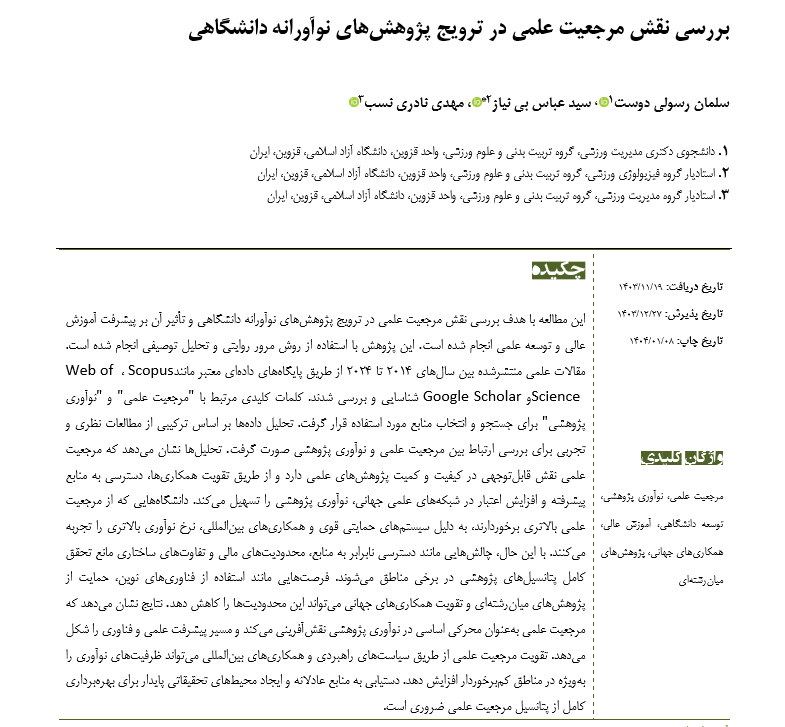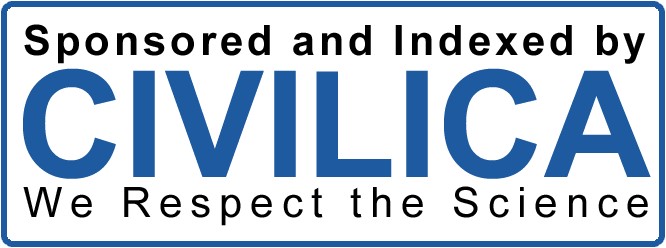بررسی نقش مرجعیت علمی در ترویج پژوهشهای نوآورانه دانشگاهی
کلمات کلیدی:
مرجعیت علمی, نوآوری پژوهشی, توسعه دانشگاهی, آموزش عالی, همکاریهای جهانی, پژوهشهای میانرشتهایچکیده
این مطالعه با هدف بررسی نقش مرجعیت علمی در ترویج پژوهشهای نوآورانه دانشگاهی و تأثیر آن بر پیشرفت آموزش عالی و توسعه علمی انجام شده است. این پژوهش با استفاده از روش مرور روایتی و تحلیل توصیفی انجام شده است. مقالات علمی منتشرشده بین سالهای ۲۰۱۴ تا ۲۰۲۴ از طریق پایگاههای دادهای معتبر مانند Scopus، Web of Science و Google Scholar شناسایی و بررسی شدند. کلمات کلیدی مرتبط با "مرجعیت علمی" و "نوآوری پژوهشی" برای جستجو و انتخاب منابع مورد استفاده قرار گرفت. تحلیل دادهها بر اساس ترکیبی از مطالعات نظری و تجربی برای بررسی ارتباط بین مرجعیت علمی و نوآوری پژوهشی صورت گرفت. تحلیلها نشان میدهد که مرجعیت علمی نقش قابلتوجهی در کیفیت و کمیت پژوهشهای علمی دارد و از طریق تقویت همکاریها، دسترسی به منابع پیشرفته و افزایش اعتبار در شبکههای علمی جهانی، نوآوری پژوهشی را تسهیل میکند. دانشگاههایی که از مرجعیت علمی بالاتری برخوردارند، به دلیل سیستمهای حمایتی قوی و همکاریهای بینالمللی، نرخ نوآوری بالاتری را تجربه میکنند. با این حال، چالشهایی مانند دسترسی نابرابر به منابع، محدودیتهای مالی و تفاوتهای ساختاری مانع تحقق کامل پتانسیلهای پژوهشی در برخی مناطق میشوند. فرصتهایی مانند استفاده از فناوریهای نوین، حمایت از پژوهشهای میانرشتهای و تقویت همکاریهای جهانی میتواند این محدودیتها را کاهش دهد. نتایج نشان میدهد که مرجعیت علمی بهعنوان محرکی اساسی در نوآوری پژوهشی نقشآفرینی میکند و مسیر پیشرفت علمی و فناوری را شکل میدهد. تقویت مرجعیت علمی از طریق سیاستهای راهبردی و همکاریهای بینالمللی میتواند ظرفیتهای نوآوری را بهویژه در مناطق کمبرخوردار افزایش دهد. دستیابی به منابع عادلانه و ایجاد محیطهای تحقیقاتی پایدار برای بهرهبرداری کامل از پتانسیل مرجعیت علمی ضروری است.
دانلودها
مراجع
Zhylinska О, Sitnicki MW, Викулова А. Systematic Assessment of the Innovative Potential of a Research University.
Baltic Journal of Economic Studies. 2019;5(2):38. doi: 10.30525/2256-0742/2019-5-2-38-44.
Castellanos ECO, Delgado LDG. Strategic Innovation: Conception of Innovation Among Social Sciences Researchers
in Higher Education in Northwestern México. Innovative Higher Education. 2022;47(5):855-74. doi: 10.1007/s10755-022-
-8.
Bednarczyk G, Trzmielak D. The Innovative Potential of Scientific and Research Units in the Process of
Entrepreneurial Discovery — Examples From Selected Eu Regions. Marketing of Scientific and Research Organizations.
;46(4):115-36. doi: 10.2478/minib-2022-0024.
Romanovskyі O, Romanovska YY, Romanovska OO. The Impact of Academic Capitalism on the Formation of
Innovation Policies in Higher Education and Science. Baltic Journal of Economic Studies. 2021;7(5):169-83. doi:
30525/2256-0742/2021-7-5-169-183.
Ge S, Hui X, Wan Q. Research on the Strategy of Students' Ability to Innovate in Science and Technology.
International Journal of Information and Education Technology. 2018;8(11):838-41. doi: 10.18178/ijiet.2018.8.11.1150.
Elnasri A, Fox KJ. The Contribution of Research and Innovation to Productivity. Journal of Productivity Analysis.
;47(3):291-308. doi: 10.1007/s11123-017-0503-9.
Nepelski D, Piroli G. Organizational Diversity and Innovation Potential of EU-funded Research Projects. The Journal
of Technology Transfer. 2017;43(3):615-39. doi: 10.1007/s10961-017-9624-6.
Fan G, Huang Z, Sun H, Li Z, Wu X, Li C, et al. Construction and Analysis of Evaluation Model for Medical Students'
Innovation Competency Based on Research‐oriented Biochemistry and Molecular Biology Course in China. Biochemistry and
Molecular Biology Education. 2023;51(3):263-75. doi: 10.1002/bmb.21719.
Fadeykina NV, Bieiadovskii T, Malina S. The Level of Research and Development Sector Involvement in the
Implementation of Regions' Innovative Growth. 2018. doi: 10.2991/cssdre-18.2018.51.
Jia Y, Liu C, Chen Y, Zhu Q. The Construction of Science and Technology Innovation Policy Design Framework—
take Shandong Province as an Example. Journal of Industry-University Collaboration. 2020;2(1):34-48. doi: 10.1108/jiuc-08-
-0015.
Xu F, Wu L, Evans JA. Flat Teams Drive Scientific Innovation. Proceedings of the National Academy of Sciences.
;119(23). doi: 10.1073/pnas.2200927119.
Zhu Z, Cui S, Wang Y, Zhu Z. Exploration on the Collaborative Relationship Between Government, Industry, and
University From the Perspective of Collaborative Innovation. Applied Mathematics and Nonlinear Sciences. 2022;7(2):903-
doi: 10.2478/amns.2021.2.00174.
Sitnicki MW. Determining the Priorities of the Development of EU Research Universities Based on the Analysis of
Rating Indicators of World-Class Universities. Baltic Journal of European Studies. 2018;8(1):76-100. doi: 10.1515/bjes-2018-
Skyba M. Innovative Potential: Research on the Scientific-Categorical Apparatus of Innovation Economy. Economies
Horizons. 2019(1(8)):63-76. doi: 10.31499/2616-5236.1(8).2019.175426.
Li C, Hou YL, Liu GY. Expanding of College Students’ Scientific Quality and Innovation With the Carrier of Research
Program. Advanced Materials Research. 2010;171-172:90-3. doi: 10.4028/www.scientific.net/amr.171-172.90.
Li Y. Foreign Research Project Management Practices and Experience Inspiration for China. 2023:974-80. doi:
2991/978-94-6463-256-9_95.
Liu H. A Visualized Analysis of Scientific Research Evaluation in Colleges and Universities Based on the Scientific
Knowledge Mapping. 2023:930-9. doi: 10.2991/978-94-6463-262-0_96.
Qi Y, Wang J. A Talent Cultivation Model for Improving the Innovation Ability of College Students in Scientific
Research. International Journal of Emerging Technologies in Learning (Ijet). 2020;15(18):151. doi: 10.3991/ijet.v15i18.16745.
Symakov V. Scientific Achievements in the Field of Research of Innovative Economic Forms of Entrepreneurship.
Economies Horizons. 2019(4(11)):65-73. doi: 10.31499/2616-5236.4(11).2019.219073.
Stone C, Dogbey G, Klenzak S, Fossen K, Tan BM, Brannan GD. Contemporary Global Perspectives of Medical
Students on Research During Undergraduate Medical Education: A Systematic Literature Review. Medical Education Online.
;23(1):1537430. doi: 10.1080/10872981.2018.1537430.
Lin Q, Song B. A Literature Review of New Types of Scientific Research Institutions. 2019. doi: 10.2991/jahp19.2019.113.
Tan C. Research on the Path of Sports Sociology Curriculum From the Interdisciplinary Perspective. Mobile
Information Systems. 2022;2022:1-8. doi: 10.1155/2022/3415257.
Taubayev A, Rakhmetova A, Kalkabayeva G, Saifullina Y, Жукенов БМ. Problems of Research Funding in the AgroIndustrial Complex of Kazakhstan. Journal of Asian and African Studies. 2022;58(8):1656-64. doi:
1177/00219096221097664.
Wang H, Yang C, Meng M, Zeng Y. Research on the Initiative Scientific Research and Innovation Behavior of
Postgraduates: Based on the Theory of Planned Behavior. Frontiers in Psychology. 2022;13. doi: 10.3389/fpsyg.2022.839981.

دانلود
چاپ شده
ارسال
بازنگری
پذیرش
شماره
نوع مقاله
مجوز
حق نشر 2025 نشریه پژوهش و نوآوری در تربیت و توسعه

این پروژه تحت مجوز بین المللی Creative Commons Attribution-NonCommercial 4.0 می باشد.










